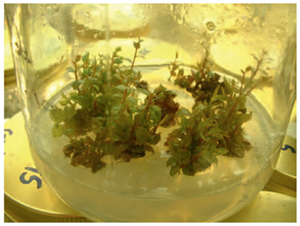Tissue culture
ContentTissue culture is a method used for vegetative propagation based on the phenomenon that any part of a plant from a single cell to a whole apical meristem can grow into a whole plant (see totipotency). The explant, the piece of the plant taken, is grown in a sterile artificial medium that supplies all vitamins, mineral and organic nutrients. The medium and explant are enclosed in a sterile jar or tube and subjected to precisely controlled environmental conditions. This method has advantages over conventional propagation techniques, since large numbers of propagules can be produced from one original plant. It has particular value with rare or novel plants. An added advantage is the reduced time taken for bulking up plant stocks. Some species that traditionally propagate only by seed, e.g. orchids and asparagus, can now be grown by this means. One of the problems of conventional vegetative propagation is that diseases and pests are passed on to the propagules. Disease levels, particularly virus, in their growing tips can be greatly reduced by exposing stock plants to high temperatures. Following this heattreatment, a meristem-tip can be dissected out of the stem and grown in a tissue culture medium, to produce stock that is free from disease (e.g. chrysanthemum stunt viroid, see Horticultural diseases and disorders). This method of propagation is now used for species including Begonia, Alstroemeria, Ficus, Malus, Pelargonium, Boston fern (Nephrolepsis exaltata), roses and many others.
Both auxin and cytokinin must be included in a tissue culture medium, at concentrations appropriate to the species and the type of growth required; the proportions of each determines whether it is roots or stems that are promoted. Short initiation is promoted by a high cytokinin to auxin ratio whereas high auxin to cytokinin ratios favour root initiation. The subsequent weaning of plantlets from their protected environment in tissue culture conditions requires care and usually conditions of high relative humidity, shade and warmth. |





